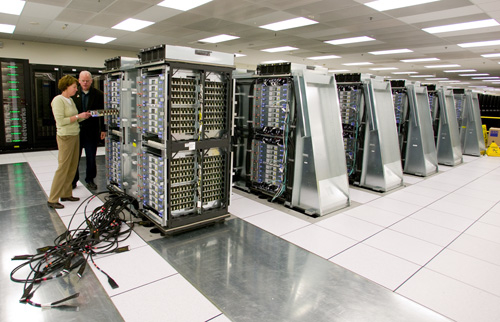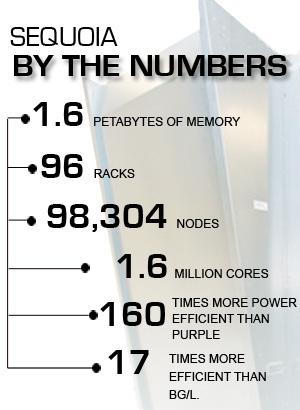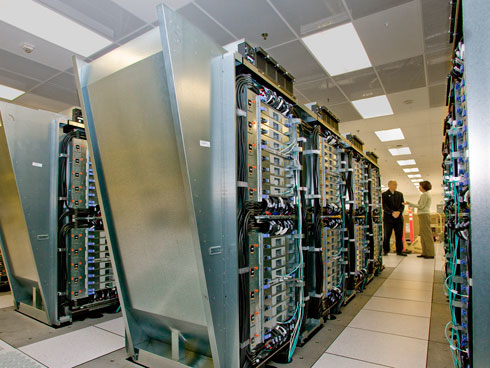Sequoia marks Dawn of new computing era
A new era in scientific computing will begin at the Laboratory when Sequoia brings its gargantuan 20-quadrillion-operations-per-second number-crunching power to the National Nuclear Security Administration’s effort to ensure the safety and reliability of the nation’s nuclear deterrent without testing.
Under terms of a new subcontract LLNS recently concluded with IBM, Sequoia will be delivered in the first half of 2011. Delivery began on Jan 20, 2009 of an initial delviery system called Dawn, a 500-teraFLOP/s (500 trillion floating operations per second) system. Dawn will serve to lay the hardware and software foundation for Sequoia. Sequoia and Dawn, named for the giant long-lived trees common to California, are next generation BlueGene systems.
"Sequoia will provide for necessary advances in the understanding of weapons science as well as vastly improved estimates of uncertainty in predictions of weapons behavior. Both are vital to ensuring confidence in our nuclear deterrent as these weapons age decades beyond their intended deployment life," said Bruce Goodwin, Principal Associate Director for Weapons and Complex Integration at LLNL. "The advances in applications and the hardware on which Sequoia will be built represent a giant step forward for the predictive simulations that are at the heart of certification of the nuclear stockpile."
Building on the high-performance computing success of BlueGene/L (BG/L), Dawn (a BlueGene/P system) will serve as a bridge and accelerate the development of the petaFLOP/s computing Sequoia will make possible. Dawn will be used principally as a code development and scaling platform for Tri-Laboratory weapon science codes targeted at Sequoia. BG/L, which held the No. 1 ranking on the Top500 list of the world’s fastest supercomputers for nearly three years (2004-2007), continues to produce breakthrough calculations for the Advanced Simulation and Computing (ASC) program.
Sequoia will be used to address stockpile stewardship and complex transformation requirements for 2012 through at least 2017, focusing on "uncertainty quantification" (UQ), an emerging branch of computer science and materials science. UQ is the quantitative characterization and reduction of "uncertainty," or error, in computer applications. UQ is analogous to the margin of error or error brackets attached to data cited in scientific and technical research papers.
The broad NNSA predictive simulation needs that will be supported by Sequoia’s computational capabilities include: support for an agile design and certification infrastructure; improved accuracy in material property data; more accurate models for known physical processes; new models for physics currently missing from applications; and vastly improved algorithm performance for macro-scale and multi-physics simulation codes.
Materials science calculations on Sequoia will facilitate the development of advanced equation-of-state, melt and transport property models, and will help scientists better understand fundamental questions about instabilities, high-explosives shock initiation and material strength dislocation dynamics. Sequoia will be capable of achieving performance levels 12 to 24 times what can currently be done on ASC Purple for UQ suites of integrated coupled physics calculations, and 20 to 50 times what can currently be done on BG/L with materials science codes.
"Sequoia represents an extremely bold step in simulation for the ASC program. We have, in the past, explored, matured and exploited high-performance computers to build the 3D codes and do our day-to-day work as efficiently as possible," said Michel McCoy, head of LLNL’s ASC program. "To tackle the challenges of predictive simulation we face today requires us to build better science models and quantify uncertainty in our integrated calculations. To do this we need a Sequoia-class system. Never before have we taken an advanced HPC architecture system and proposed to inject it into a mainline production environment at this scale. We will work closely with our customers and collaborators at all three labs to move the critical codes onto this multi-core architecture. This is a daunting step in itself, and the reason why Dawn (BG/P) is so important to this endeavor."
McCoy noted that exploiting Sequoia as an "uncertainty quantification engine" will require researchers to simultaneously run suites of calculations, which previously could only be run individually on ASC Purple, to better understand the sources of errors in these calculations. "This is a mammoth effort for the ASC program, and because of this kind of aggressive programmatic driver, NNSA will continue to lead the nation in simulation. And we will exploit what we will learn to support the breadth of research efforts at LLNL."
Explaining the increasingly important role that high-performance simulations play in scientific discovery, Mark Seager, assistant department head for new technologies, told Wired magazine: "Scientific simulation is the telescope of the mind. We work with highly nonlinear systems that have very complicated mathematics and models. It’s just too difficult to hold all that in our brain and analyze it. So by simulating them, we’re extending our brains’ capabilities."








